6
By Keelan Boyle, Isabella Clowes, and Katharine Miller
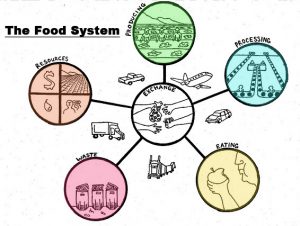
One of the most important systems in our society is the food system. Crops, such as vegetables and cereals, form the base of the food system because they are grown to be sold, processed, or fed to livestock. The food system also includes water and energy consumption, food processing, transportation, retail, and human health (Ericksen, 2008). Despite our huge industrialized system of perfectly engineered farms, about two billion people are still malnourished and about 50 million people in the US alone experience food insecurity (Ziska, 2017). There is plenty of food to go around but it often is not distributed evenly, with much of it going to waste before it is purchased or even thrown out for not looking “good enough”. These devastating figures of starvation could increase soon as our current food system is harmed by climate change.
The history of the food system is important in understanding how vulnerable it is to climate change. In the past, farmers were limited to the preexisting nutrients in the soil. Crops needed to be rotated yearly because they each depleted different nutrients out of the soil and eventually were unable to grow there. This changed when Fritz Haber developed a way to create ammonia. He used high pressure and temperature to combine nitrogen in the air with hydrogen, now called the Haber-Bosch process (Ziska, 2017). This process is used to create fertilizers and requires the burning of fossil fuels, which contributes to climate change itself. With extra nutrients, plants grew exceptionally large but ended up falling over, reducing the yield. This led Norman Borlaug to identify special varieties of plants that did not fall over and were resistant to diseases (Ziska, 2017). From this point on, farms specialized in singular species of crops rather than planting a diverse group of them. This method works; however, if a disease or invasive species is introduced that can kill one plant in the field, then the entire field will be compromised since the plants all have the same weaknesses.
Climate change has the potential to harm all aspects of the food system but the most direct impacts of climate change on the system will occur in food production. These effects are expected to be widespread and complex. Theoretically, rising atmospheric concentrations of CO2 could increase crop yields since CO2 is an essential nutrient needed for plant growth; however, other factors such as temperature and limited access to other nutrients could counteract these benefits (EPA, n.d.). Furthermore, the same factors which could increase crop yields would also allow weeds to thrive and choke out the desirable crops. Rising concentrations of CO2 are also linked to a decrease in protein levels of grains and potatoes, lowering their nutritional value and thereby increasing the amount necessary to maintain a healthy diet (Vermeulen et al., 2012). Another way in which climate change will affect crops is through the increased frequency of extreme temperatures and weather events. As technology has improved, crop yields have consistently improved as well, leading to fewer farms producing a larger portion of the food supply (usually with only one crop each). Extreme weather events such as droughts and floods pose a serious risk to our food system because they can significantly harm crop yields, as demonstrated by Figure 2. As climate change continues extreme weather events will only continue to worsen in both frequency and severity causing increased variability and uncertainty within the crop production system.
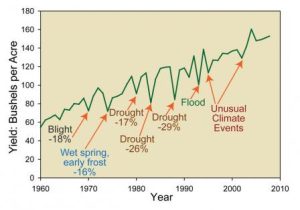
Livestock is also threatened by climate change. Heat waves, which have been increasing in recent years, pose a serious threat to the well-being of animals because over time heat stress can increase vulnerability to disease and reduce fertility in animals (EPA, n.d.). Other impacts of climate change also have large ramifications on livestock; for example, droughts will likely have a twofold effect. Firstly, when there is a drought there is less water for animals to drink, and secondly, droughts also effect grain production and grass growth, decreasing the amount available for feeding livestock (EPA, n.d.). The rising CO2 levels that are affecting the nutritional value of crops, will also affect livestock because the grains that they are fed will be lower in nutritional value and thus they will need more food to continue getting sufficient nutrients. Thus, creating a feed positive feedback loop.
The third sector of food production, fisheries, has similarly been affected by climate change. As oceans warm, many species of aquatic life are steadily migrating northward in search of cooler climates (EPA, n.d.), impacting human’s abilities to collect fish, along with causing many potential harms to the already established ecosystems these fish are moving to. The warming ocean is also causing disease outbreaks in many of the species of marine life humans rely on as part of our diet. Furthermore, the acidification of the ocean is causing serious harm to many species including shellfish, where rising acidity is causing the weakening of their shells (EPA, n.d.).
Beyond the impacts on food production, climate change is expected to have many secondary effects as well. Extreme weather events pose a major threat to food storage infrastructure. As temperatures rise, the perishability of food will increase, making cold storage more essential for the storage and transportation of meats and fresh produce. The prices associated with this cold storage are also likely to rise as climate change worsens (Vermeulen et al., 2012). This includes transportation via truck, boat, and train. Many rivers will cycle between floods and droughts making those shipping routes extremely difficult and unreliable, an effect that has already begun to arise across the world (EPA, n.d.). Furthermore, the melting of permafrost will put many roads and land shipping routes, that rely on the permafrost layer being intact, in jeopardy (Vermeulen et al., 2012). Transportation of food will become increasingly variable and expensive as climate change continues. Because of the effects of climate change, prices are going to increase, there will be a decrease in food security, food will lower in nutritional value, and food will be more susceptible to bacteria and diseases that could pose a risk to the humans.
As climate change affects the food system, the food system is also degrading the global climate. In 2014, the USA moved over 500 million tons of grain across the country. It was transferred mostly by train (25%) and by truck (61%). Since trucks and trains use a substantial volume of fuel to run, they emit a significant amount of greenhouse gasses (GHG) into the air. The average truck emits 16.8 grams of CO2 per ton-mile, while food travels around 1000 miles via trucks (Mathers, 2020). Therefore agriculture-carrying trucks produce 5.1 million tons of CO2 each year in the USA alone. One way to decrease the emissions caused by transportation is to buy local produce. Buying a head of lettuce that traveled hundreds of miles to the supermarket, uses a lot more carbon than the relatively few miles needed to travel to a farmer’s stand. This change however can only go so far. Since there is very little space for farmland near the city, millions of people living in urban areas don’t have the option of buying local. Some food will still need to be transported large distances to support everyone. But if there was more local produce available (home gardens or local farms), the total transport emissions could be cut down.
Just as significant in the food system’s contributions to climate change is the clearing and destruction of ecosystems. This can come in many forms, from deforestation, to the poisoning of soil and water. Deforestation happens because as farmers want to expand, they must clear new spaces which already has other life occupying it. By doing this, farmers are destroying the habitats of the plants and animals living in the forest. At the same time, it is putting more carbon into the air. Most plants (especially trees) sequester carbon throughout their life and release that carbon when they die. Decomposers will break down the dead plants and the gasses inside the cells will be released back into the air. This is most evident in the Amazon Rain Forest where four million acres have been cut down for farming (Gibbens, 2019).
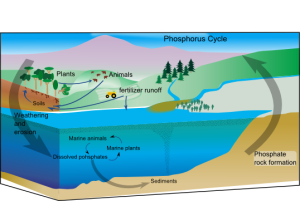
Additionally, once the plants are planted, they are often fertilized with inorganic fertilizer. When these fertilizers are put into the ground, the plants absorb the phosphorus, nitrogen, and heavy metals that are in the fertilizers. Animals eat these metals and get sick while also spreading them. This causes negative effects to local ecosystems (Savci, 2012). The excess nitrogen and phosphate get washed into rivers, wetlands, and underground water supplies (Figure 3). Intuitively this may not seem bad since humans give plants these nutrients but in large quantities there are serious environmental hazards. This is because if excess phosphorus is added to a body of water, the number of algae increase exponentially. This process is called “Eutrophication” (Ayoub, 1999). As the process continues, the algae use all the oxygen in the water, eventually suffocating all the life in that body of water (Bishop, 2015). Additionally, the nitrogen, even at very small amounts, makes the water toxic to plants and animals (including humans). This makes farming harder since the local water needs to be treated before use.
There are many different approaches to prepare for the future which include buying more land and using more fertilizer, but these do not help the environment or protect it. To truly plan and adapt to the changing climate, new farming policies, infrastructure, and education efforts must be made. This is to ensure that farms and the whole food system can be sustained and better protected. As of now in the USA, the USDA (United States Department of Agriculture) has put forward recommended solutions to potential problems that will be occurring in upcoming years. This includes changes in precipitation, soil nutrient depletion, stronger droughts, and overall variance in growth conditions.
One method to keep farmers from cutting down forests for more land would be to pay or incentivize farmers to keep forests. This could be achieved by paying farmers not to cut down forests and or helping improve efficiency of farms via sustainable methods. The funds to protect the forests could come from governments or companies that want to protect the environment. Another way to protect farmers is to implement a crop insurance system that would limit the uncertainty of income for a given year. This would allow farmers to always earn something even if their crops fail for a year. It would no longer be a necessity for farmers to expand their land to survive. With the financial relief farmers would not be driven by necessity to expand and that they are rewarded for not expanding they can work on resource efficiency instead.
The primary goal of this efficiency is to decrease the negative impact of fertilizers on the surrounding area. A way of achieving this is via water management systems. They can be installed to decrease the run-off of fertilizer, specifically phosphorus, into the surrounding environment. One way to do this is to use a system called “drip-irrigation”. This slowly drops water into the soil and fertilizers can be applied more effectively to the plants (Shock, 2014). This makes fertilizer more efficient and less water is needed. One downside to this process is that it is expensive to install and requires more maintenance than standard irrigation. However, with increasing support from the public and government, this is could be a viable method for limiting climate change while increasing the efficiency of farmer’s land. This will not be enough on its own, however. As the planet moves towards environmental sustainability, there are many different factors at play and the food system is one of the more important ones.
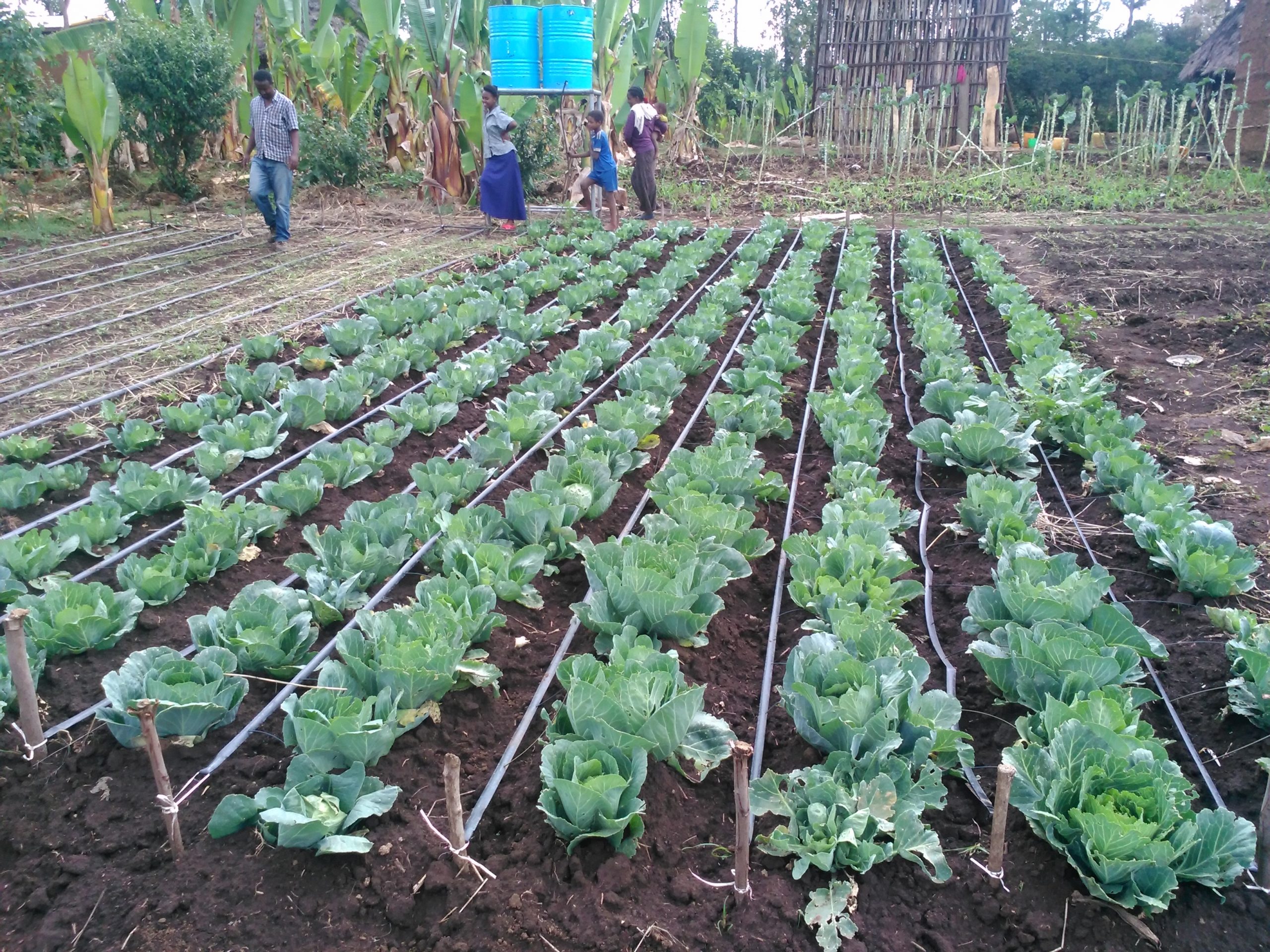
If our current agriculture system fails, not everyone will be affected equally. As with many other issues in our society, those with less money will be harmed the most. People living in poverty already experience food insecurity and constantly wonder when they will be able to eat next. Even with steady jobs, many people still live paycheck-to-paycheck, struggling to afford enough food for their growing children. Many of these people reside in urban areas that lack proper updated infrastructure and have poor resources such as inadequate supermarkets and limited options. When climate change leads to big decreases in food production, the prices will rise drastically, expanding food insecurity to millions more people (Wheeler & von Braun, 2013). Shortages in stores would also occur as people stock up and hoard food in fear of not having access to any at all. Subsequently, severe inflation would drive up prices even more, making the poor poorer and the rich richer as they profit off other’s struggles, widening the social gap.
People of different races would also be disproportionately affected by climate related changes to the food system. As of right now, a higher percentage of people of Hispanic or African backgrounds face food insecurity in the U.S., expressed in Figure 5. This divide would only be exacerbated by climate change because Hispanics and African Americans are offered less access to support and resources in their communities (Silva, 2020).
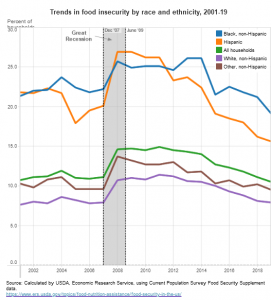
Food availability also varies by region or country. Recently the countries suffering from the most starvation and malnutrition are in Southern Asia or sub-Saharan Africa. Studies and models predict that food will only become scarcer in those regions as climate change harms food production. Figure 6 displays this imbalance of change, showing how most industrialized northern regions will maintain a good production of food while developing southern regions will see big decreases in crop yields by 2050. Africa and South Asia are predicted to experience an average decline in crop yields of about 8% by 2050 (Wheeler & von Braun, 2013). Differences in how climate change effects various regions are due to the preexisting diseases, invasive species, and patterns of rainfall and how susceptible these factors are to climate change. It’s very clear that new operations of growing, processing, and distributing the food supply need to be implemented soon in order to prevent these vulnerable regions from seeing even more starvation and malnutrition.
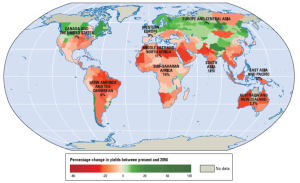
Human health around the globe relies heavily on food accessibility. Many factors of climate change can harm individual health, but changes to food are arguably the most impactful. Damage to the food system caused by climate change may leave many people with no access to certain key food groups that are essential for nourishment and well-being. Depending on where someone lives, they may not be able to buy fruits, vegetables, grains, or meat. High quality, nutrient dense foods may be in short supply as well, leaving undesirable and non-nutritious foods as the only option for most people. One study estimates that by 2050, the consumption of fruits and vegetables will decrease by 4% and consumption of red meat will decrease by 0.7% (Springmann et al., 2016). These global diet changes could result in about 529,000 extra deaths related to climate change each year. Although the change seems small, the health impact takes a large toll on our bodies. This same study predicts that if we could reduce human contributions to climate change and find new ways to produce our food, there could be a decrease in climate related deaths of at least 29% (Springmann et al., 2016). Therefore, figuring out solutions to these future problems is crucial. 2050 is not that far away so we need to adapt our food infrastructure immediately to save thousands of lives and prevent suffering before it is too late.
References
Ayoub, A. T. (1999). Fertilizers and the environment. Nutrient Cycling in Agroecoystems, 55, 117-121. https://doi.org/10.1023/A:1009808118692
Bishop, W. (2015, July 7). The impact of phosphorus pollution on waterbodies. SOLitutde Lake Management. https://www.solitudelakemanagement.com/blog/the-impact-of-phosphorus-pollution-on-waterbodies.
Bryan, E., Deressa, T. T., Gbetibouo, G. A., & Ringler, C. (2009). Adaptation to climate change in Ethiopia and South Africa: Options and constraints. Environmental Science & Policy, 12(4), 413-426. https://doi.org/10.1016/j.envsci.2008.11.002
CUESA (Center for Urban Education about Sustainable Agriculture). (2018, February 5). How far does your food travel to get to your plate? CUESA. https://cuesa.org/learn/how-far-does-your-food-travel-get-your-plate.
EPA (US Environmental Protection Agency). (n.d.). Climate impacts on agriculture and food supply. Climate Change Impacts, US Environmental Protection Agency. https://archive.epa.gov/epa/climate-impacts/climate-impacts-agriculture-and-food-supply.html
Ericksen, P. J. (2008). Conceptualizing food systems for global environmental change research. Global Environmental Change, 18(1), 234–245. https://doi.org/10.1016/j.gloenvcha.2007.09.002
Gastelle, J., Caffarelli, P., Chang, K.-L., & Marathon, N. (2017, October). Transportation of U.S. grains: A modal share analysis. U.S. Dept. of Agriculture, Agricultural Marketing Service. https://www.ams.usda.gov/sites/default/files/media/ModalOctober2017.pdf
Gibbens, S. (2019, April 26). This map shows millions of acres of lost Amazon rainforest. National Geographic. https://www.nationalgeographic.com/environment/2019/04/three-million-acres-brazil-rainforest-lost/.
International Atomic Energy Association. (n.d.). Agricultural water management. IAEA. https://www.iaea.org/topics/agricultural-water-management.
Mathers, J. (2020, February 6). Green Freight Math: How to Calculate Emissions for a Truck Move. EDF+Business. https://business.edf.org/insights/green-freight-math-how-to-calculate-emissions-for-a-truck-move/.
Savci, S. (2012). Investigation of effect of chemical fertilizers on environment. APCBEE Procedia, 1, 287-292. https://doi.org/10.1016/j.apcbee.2012.03.047
Shock, C. (2014, August). An introduction to drip irrigation. Oregon State University, College of Agricultural Sciences. https://agsci.oregonstate.edu/mes/irrigation/introduction-drip-irrigation
Silva, C. (2020, September 27). Food insecurity in the U.S. by the numbers. National Public Radio. https://www.npr.org/2020/09/27/912486921/food-insecurity-in-the-u-s-by-the-numbers
Springmann, M., Mason-D’Croz, D., Robinson, S., Garnett, T., Godfray, H. C. J., Gollin, D., Rayner, M., Ballon, P., & Scarborough, P. (2016). Global and regional health effects of future food production under climate change: A modelling study. The Lancet, 387(10031), 1937-1946. https://doi.org/10.1016/S0140-6736(15)01156-3
Vermeulen, S. J., Campbell, B. M., & Ingram, J. S. I. (2012). Climate change and food systems. The Annual Review of Environment and Resources, 37, 195-222. https://doi.org/10.1146/annurev-environ-020411-130608
Walthall, C. L., Hatfield, J., Backlund, P., Lengnick, L., Marshall, E., Walsh, M., Adkins, S., Aillery, M., Ainsworth, E. A., Ammann, C., Anderson, C. J., Bartomeus, I., Baumgard, L. H., Booker, F., Bradley, B., Blumenthal, D. M., Bunce, J., Burkey, K., Dabney, S. M., … Ziska, L. H. (2012). Climate change and agriculture in the United States: Effects and adaptation. USDA Technical Bulletin 1935. Washington, DC. 186 pages. https://lib.dr.iastate.edu/cgi/viewcontent.cgi?article=1000&context=ge_at_reports
Wheeler, T., & von Braun, J. (2013). Climate change impacts on global food security. Science, 341(6145), 508-513. https://doi.org/10.1126/science.1239402
Ziska, L. H. (2017). Agriculture, climate change and food security in the 21st century: Our daily bread. Cambridge Scholars Publishing.
